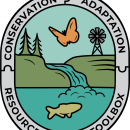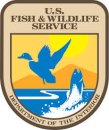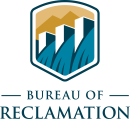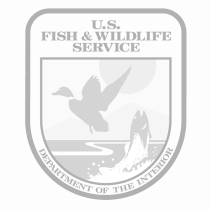Location
States
UtahEcosystem
River/streamIntroduction
Lake Powell is the second largest reservoir in the United States, established at the junction of the San Juan and Colorado Rivers following the construction of Glen Canyon Dam in 1963. The accumulation of sediment when the reservoir was full and the subsequent decline in water levels resulted in the river rerouting out of the original channel to a sandstone ledge and forming a waterfall at Piute Farms, upstream of the San Juan River inflow to Lake Powell. This waterfall has become a known barrier to fish movement. Lake levels rose shortly after formation of this waterfall, temporarily allowing fish passage fish passage
Fish passage is the ability of fish or other aquatic species to move freely throughout their life to find food, reproduce, and complete their natural migration cycles. Millions of barriers to fish passage across the country are fragmenting habitat and leading to species declines. The U.S. Fish and Wildlife Service's National Fish Passage Program is working to reconnect watersheds to benefit both wildlife and people.
Learn more about fish passage to and from Lake Powell to the San Juan River. Levels began declining again in 2001, and the waterfall has been present since that time except for two weeks when it was inundated in the summer of 2011.
River managers in the San Juan River Basin Recovery Implementation Program (SJRRIP) began using a newly adopted passive integrated transponder (PIT)-tag antenna to remotely monitor native fish at this location in 2014.
Conservation of native species requires increased understanding of how fish use this ecosystem, a reservoir and river fragmented by the waterfall. Razorback Sucker (RS; Xyrauchen texanus) and Colorado Pikeminnow (CP; Ptychocheilus lucius) are two intensively managed endemic species that are listed as endangered under the Endangered Species Act (ESA). River managers stock CP and RS annually as part of their recovery plans in the San Juan River. Many of these fish pass over the waterfall and are unable to return upstream. During stocking and recapture events between 2000 and 2017, managers implanted over 140,000 RS and 50,000 CP with PIT-tags after moving them upstream of the waterfall in the San Juan River. Tracking the movements of these PIT-tagged fish helps researchers understand how fragmentation in the Colorado River Basin affects the movement of these imperiled fish.
Key Issues Addressed
Fish in Lake Powell have no access to upstream habitat due to the Piute Farms waterfall, which is an impassable barrier. Researchers hypothesize that RS experience a recruitment bottleneck in early life stages with few wild-spawned larval fish surviving to the juvenile life stage because of this barrier. Passage from Lake Powell to the San Juan River above the waterfall would allow spawning in upstream habitats and would increase the number and distribution of wild-spawned larvae.
Researchers needed to determine if human assistance was a necessary management action to return fish upstream once they went over the waterfall. SJRRIP managers used remote monitoring of PIT-tagged fish to determine how fish translocated from below the waterfall used upstream habitat and if they returned back downstream of the waterfall.
Project Goals
- Estimate population sizes of endangered fish downstream of the Piute Farms waterfall and translocate fish back upstream of the waterfall
- Determine the extent to which translocated fish use upstream habitat, and identify what proportion of fish that were moved upstream pass back below the waterfall
- Develop methods to remotely track PIT-tagged fish as they move from the San Juan River over the waterfall to Lake Powell
- Collaborate with partners to PIT-tag, monitor, and compile location data of fish into a centralized database
Project Highlights
- PIT-Antenna to Assess Passage: SJRRIP researchers used a remote solar-powered antenna downstream of the waterfall to monitor PIT-tagged RS and CP in spring of 2014 through 2022, when managers believe fish attempt to move upstream to spawn. PIT-tag antennas replaced more laborious capture/recapture methods formerly used to assess population dynamics. Researchers detected CP using the antennas but there were not enough fish to perform population estimates.
- Assisted Passage: River managers have detected more than 2,000 individual RS since deploying their PIT-tag antenna in 2014. Managers transported approximately 200 stranded RS and 20 CP upstream of the waterfall each year from 2014 to 2021.
- Fate of Translocations: Of the 152 fish translocated in 2016, nine spent an average of 182 days upstream and traveled an average distance of 218 km. Managers encountered 123 in Lake Powell following minimal use of upstream habitat. In 2017, 20 traveled an average distance of 90 km upstream for only about 39 days, and 119 were reencountered back in Lake Powell. Movement studies are ongoing; however, river managers found that translocations are temporary and fish return back from where they originated after making some use of upstream habitats. RS seemed to congregate in areas of the San Juan where spawning gravels were available.
Collaboration for Data Compilation: The U.S. Fish and Wildlife Service (USFWS), Bureau of Reclamation, National Park Service, and Navajo Nation collaborated on permitting for this project. The National Park Service cooperated as the land manager of the lower river, and Kansas State University (KSU) graduate students implanted PIT-tags and translocated fish upstream of the waterfall. USFWS, Navajo Nation, New Mexico Department of Game and Fish, Utah Division of Wildlife Resources, and KSU students conducted surveys and collected location data for this project.
Lessons Learned
Non-native Barrier: While the waterfall has negative impacts on native fish, it also serves as a barrier to non-native fish, preventing them from entering the San Juan River from Lake Powell.
Using PIT-antennas continuously at a location within the Colorado River Basin illustrated how remote data collection can more efficiently (more encounters for less effort) track movements and population numbers compared to capture and recapture methods. Researchers have adjusted the sampling period over time based on observations. For example, increasing the sampling period from 40 days in 2014, 2015, and 2016 to 110 days in 2017 yielded a greater number of unique fish detected on the PIT-antenna. While studies with PIT-antennas still continue, researchers have already filled many knowledge gaps with this new technology.
The high number of RS stocked in the San Juan River found downstream of the waterfall surprised SJRRIP biologists. The large number of fish found downstream of the waterfall made moving them upstream a necessary management option since the waterfall impedes adult fish below the waterfall from spawning in the San Juan River.
Relationships among federal and state agencies, universities, and tribal nations played a vital role in helping track fish and collect data. Many partners provided staff time to conduct surveys and collect field data, helping researchers cover more territory in the Colorado River Basin. University students performing surgeries on fish to implant radio tags and developing new antenna techniques were novel applications of this project.
Antenna detections and translocations provided new insight into the movements, behaviors, and ecology of endangered fish species inhabiting the San Juan River, providing data that could not have been collected using traditional survey methods. Ichthyological researchers are currently conducting genetic surveys on all larval fish captured in the river to assess the impact of translocated fish on spawning output of RS.
Next Steps
- Quantify spawning habitat in the 25 km reach between Lake Powell and the waterfall to further understand how this transition area supports the life history of RS, and discuss construction of a spawning bar below the waterfall to create more habitat for native fishes in the river
- Collect more data from PIT-antenna to track fish movements and continue filling gaps in movement data
- Quantify the number of translocated fish spawning above the waterfall
- Monitor numbers of fish needing translocation services from the bottom of the waterfall, and consider construction of fish passage infrastructure
Funding Partners
San Juan River Recovery Implementation Program
Resources
- Pennock et al. (2021). “Reservoir fish assemblage structure across an aquatic ecotone: Can river-reservoir interfaces provide conservation and management opportunities?” Fisheries Management and Ecology 28(1):1-13.
- Pennock et al. (2020). “Movement ecology of imperilled fish in a novel ecosystem: River-reservoir movements by razorback sucker and translocations to aid conservation.” Aquatic Conservation: Marine and Freshwater Ecosystems 30(8):1540-1551.
- Pennock et al. (2020). “Razorback Sucker Movement Strategies across a River-Reservoir Habitat Complex.” Transactions of the American Fisheries Society 149(5):620-634.
- Cathcart et al. (2018). “Waterfall formation at a desert river-reservoir delta isolates endangered fishes.” River Research and Applications 34(8):948-956.
- Casey Pennock Dissertation: Movement, habitat use, and early life history of fishes in novel river-reservoir complexes.
- San Juan Recovery Implementation Program Presentation: Facilitated passage and movement patterns of Razorback Suckers in the San Juan River.
Contacts
- Scott Durst, Science Coordinator, San Juan River Basin Recovery Implementation Program, U.S. Fish and Wildlife Service: scott_durst@fws.gov
- Mark McKinstry, Biological Scientist, Bureau of Reclamation: mmckinstry@usbr.gov
CART Lead Author
Nilisha Patel, Student Intern, Johns Hopkins University
Suggested Citation
Patel, N., Durst, S., and McKinstry, M. (2022). “Waterfall Effects on Native and Non-Native Fish Movement in the San Juan River.” CCAST. Retrieved from https://www.fws.gov/project/waterfall-effects-native-and-non-native-fish.












